Cover Feature: 2018 Executive Forecast
Executive Forecast 2018: A Look at Flexible Packaging’s Future

e-Commerce. Sustainability. Package design. Flexible packaging’s outlook remains positive, but these factors – and more – will play a role in the industry moving forward.
Eric Fish, Flexible Packaging’s Editor-in-Chief, recently caught up with industry veterans Joe Moynihan, Charles Murray, Todd Blumsack, and Laurent Cros to discuss the state of the flexible packaging industry.
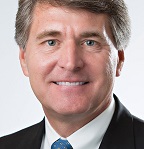
Joe Moynihan
President
Mondi Jackson
Converter
www.mondigroup.com
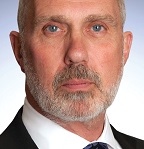
Charles Murray
President, N.A. Inks
Sun Chemical
Supplier
www.sunchemical.com
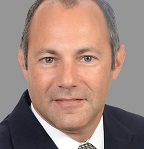
Todd Blumsack
V.P., Business Unit Web-Fed
Bobst North America
Manufacturer
www.bobst.com

Laurent Cros
CEO
Pearl Technologies Inc.
Supplier/Manufacturer
www.pearltechinc.com
Briefly recap 2017 both for your company and for the flexible packaging industry. Did it live up to your original expectations? How is 2018 forecasting?
Murray: Some sectors in the flexible packaging industry met expectations in 2017. For example, with the continued trend of consumers pushing for healthier foods, we saw growth in the areas for fresh fruits, health bars, pre-cut salads and other similar products. Other markets, such as soft drink bottles, cereal and snack foods, did not live up to expectations in 2017. We expect similar results in 2018.
Cros: 2017 was a great year for Pearl Technologies. We achieved significant growth in high-end punching, sealing and slitting equipment, and consumables that exceeded our expectations. This increase in demand resulted in a healthy increase in the number of new accounts. As we all know, Hurricane Harvey disrupted the resin supply chain and impacted resin prices. This resulted in the postponement of a few larger projects while converters and extruders assessed the recovery. Those projects are now back on track, which will boost our business activity as we enter 2018. This, along with our upcoming trade shows, should make 2018 another good year for Pearl.
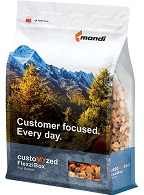
Moynihan: Consumer product flexible packaging experienced growth in many segments and sub-segments in 2017 that reached or surpassed our outlook. Growth came from both successful on-shelf and online sales of flexible packaged consumer products as well as continued conversion from rigid packaging formats. Our focus on excellence in premium packaging formats for dry pet food was especially beneficial for Mondi in 2017 as the pet food industry continued its trend towards packaging that delivers an enhanced consumer experience.
Blumsack: 2017 was a very good year for Bobst, both in North America and globally, with results exceeding the forecast for our web-fed range of machines for printing and converting flexible materials. This is thanks to several new product developments and a well-balanced positioning of our range of products between mature and emerging markets.  With 52 machines sold, our gravure printing presses have been top performers for 2017. Extrusion coating and coating machines for special applications in the food packaging and medical segments of the markets achieved record result this year, and we are satisfied with the inroads made by the new range of compact laminators, and the narrow- and mid-web inline UV digital flexo presses. The strong 2017 sales performance paves the way for a very promising 2018, which will be marked by the introduction of new developments, starting the year with the launch of our new 20SEVEN CI flexo press in February, and many more to come as the year unfolds.
With 52 machines sold, our gravure printing presses have been top performers for 2017. Extrusion coating and coating machines for special applications in the food packaging and medical segments of the markets achieved record result this year, and we are satisfied with the inroads made by the new range of compact laminators, and the narrow- and mid-web inline UV digital flexo presses. The strong 2017 sales performance paves the way for a very promising 2018, which will be marked by the introduction of new developments, starting the year with the launch of our new 20SEVEN CI flexo press in February, and many more to come as the year unfolds.
How do you assess the current flexible packaging market as it stands today? How do you think it will change – if at all – over the next year?
Moynihan: The North American flexible packaging market continues to provide opportunities for companies that meet and exceed customer expectations. We fully expect this to continue in 2018 and beyond. Consumer brands are becoming more sophisticated in the ways they work with their suppliers to customize flexible packaging with features that enhance the consumer experience and drive sales growth. At the same time, we see an increasing number of brands designing sophisticated printing approaches for their packaging, with the intent to stop consumers in their tracks as they navigate the increasingly complex consumer product marketplace.
Blumsack: Flexible packaging is a healthy business which will continue to grow. This is an important advantage for industry players and technology providers because it enables them to plan long term. Looking ahead, the demand for high-performance packaging will be strong, especially in the food and pharma segments. The focus on recyclability will also increase, due to the pressure of consumers who expect it from the products they purchase and who are ready to shift their buying preferences if they do not satisfy environmental concerns. Hence, industry collaboration will continue to intensify amongst industry players all along the packaging value chain and progress will be fast to find either monolayer or new combinations of materials that can be recycled and at the same time remain highly functional.
We also expect a growth in the industry acceptance of the safety of UV inks in flexible packaging applications for food. Also expected are advances in technology with the ability to provide continuous safety checks on the processed substrates, and the combination of energy-curable inks and control systems that deliver full compliance with even the most stringent regulations.
Murray: Mergers and acquisitions continued to play a key role in the flexible packaging marketplace in 2017, and we see that continuing in 2018 among both converters and their supply base. We have seen increased cost pressure on raw materials, such as titanium dioxide, and other feedstocks in 2017, and expect the trend to continue into 2018.
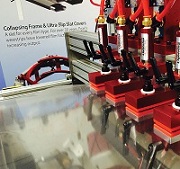
Cros: The trends continue to show the progression of flexible packaging against other forms of packaging. Pearl Technologies invested in a fully functional, in-house lab to offer customers the ability to test their films. The amount of new applications is just astounding. We see new product packages on a weekly basis, and converters are testing all kinds of new innovations, especially in the pouch arena. This is a very positive trend for Pearl Technologies, as we are very well positioned to support these new requirements.
What are some of the biggest challenges this industry currently faces? How do you think those challenges will change throughout 2018?
Blumsack: Consumer buying habits are changing with the growth of online shopping vs. traditional ways of distribution. The growth of online shopping tends to be perceived as a challenge because it does away with the packaging emotional impact that generates fast purchase decision at retailing stores, but I see it changing into an opportunity. With online buying, the product itself drives the purchase decision, while the packaging becomes a sort of surprise reward, and something not seen before. Therefore, the packaging raises interest and has the potential to become an important marketing tool which can engage the recipient, stimulating other purchases by being increasingly informative and interactive. It could also be reusable packaging that can be used differently once the content is finished
Another challenge is of course packaging recyclability. With just under 14 percent of plastic packaging being recycled worldwide, consumers are strongly demanding that brand owners ensure packaging sustainability. Flexible packaging covers a vast spectrum of products from simple monolayer material to complex multi-ply laminated structures, which can include different mixed polymers, aluminum foil and paper. Recycling of these composite materials is a complex procedure that requires the separation of each layer. However, the industry is actively looking at developing concepts into solutions that are suitable for a circular economy, mostly through industry collaborations amongst players of the production chain.
Cros: Flexible packaging continues to present many advantages compared to traditional packaging methods. The key benefits are lower manufacturing and transportation costs, increased convenience and portion control, and it is less impactful on the environment. Public perception, though, is a continued threat and will be until the recycling infrastructure is in place to minimize the amount of flexible packages in landfills and in oceans. The industry is aware of this challenge and is making great progress to address it and, over time, we believe it can overcome this perception.
One other challenge is the impact of oil prices on the price of resin that can make flexible packaging less competitive in the event of a sudden rise in costs. This can have a strong impact down the supply chain, as we have seen this year with the aftermath of Hurricane Harvey. We are confident that the many advantages of flexible packaging will drive consumer demand and will continue to fuel the growth of the industry in the foreseeable future.
Murray: There was a saying that if you send a man to buy three things at the store, he’ll come out with seven. People who shop in brick-and-mortar stores make many purchase decisions based on the emotional impact by the packaging on the shelf. With the continued growth in online shopping, purchasing those same products that we always buy every single month are now made without emotions. This lifestyle choice will continue to grow in 2018 and could affect the growth of many retail stores.
Moynihan: Our daily challenge is to exceed customer expectations. As consumer brands work to drive increased profitability, their expectations from Mondi are dynamic and multi-faceted. We challenge and empower our team to embrace change and have the flexibility necessary to partner successfully with our customers in these fast-changing times. An illustration of these multi-faceted and complex expectations can be seen in the frequent need from brands to meet their sustainability goals cost-effectively while delivering the shelf presence and product use satisfaction necessary in today’s hyper-competitive consumer goods segments.
What are some of the biggest trends that you see in flexible packaging developing in 2018 and beyond?
Moynihan: Traditionally, brands focused their flexible packaging efforts on product protection and retail display characteristics. While these remain critical, they have been joined in importance by flexible package engineering advancements and features that enhance consumer satisfaction. This holds true for the consumer’s total product experience, from researching a product category through to the product packaging’s end use.
One area where the importance of package design and engineering become especially evident is in consumer ratings of packaged goods that are purchased online. Consumers frequently refer to the presence, or lack thereof, of easy-open, resealable, easy-pour and other features as reasons to justify their online ratings of flexible packaged consumer goods.
Cros: We have been staying really close to the new innovations in pouches. We believe that newer generations of consumers will continue to embrace better ways of consuming a wide range of products, from health and beauty products to perishable and non-perishable food products. Trends such as online grocery purchasing, smaller and more convenient batches of food packaging rather than buying in bulk, and the increasing demand in quality products reflected in high-end packaging are all trends that continue to evolve in a way that pushes the industry to continuously innovate new pouch solutions.
Murray: The industry is and will continue to work hard to educate the public that flexible packaging is environmentally sound. One possible roadblock to the ongoing growth of flexible packaging is public perception. We see public outcries for the banning of plastic shopping bags or other flexible packaging when they don’t understand the realities. We expect environmental pressures for recycling to continue to grow, but the reality is that there is significant collaboration of all partners in the supply chain – converters, ink suppliers, CPGs, brand owners, printers, etc. – to produce environmentally-friendly packaging, even if it costs a little more to do so.
Blumsack: The relationship between technology providers, converters and brand owners will continue to evolve with the formers having a major role to play on the basis of their ability to provide for basic packaging output, color and quality repeatability rather than lower production costs. The consistency of color anywhere in the world is one of the essential elements for brands to maintain the level of perceived quality, which is so strongly related to the purchasing behavior of consumers.
Higher performance packaging and higher efficiency in the press room generates stronger needs for product differentiation, both graphic and sensorial effects, which will bring about an increase in hybrid applications, be they digital or analogic, which reflects on the equipment for production of these enhanced packaging material.
Looking for a reprint of this article?
From high-res PDFs to custom plaques, order your copy today!






